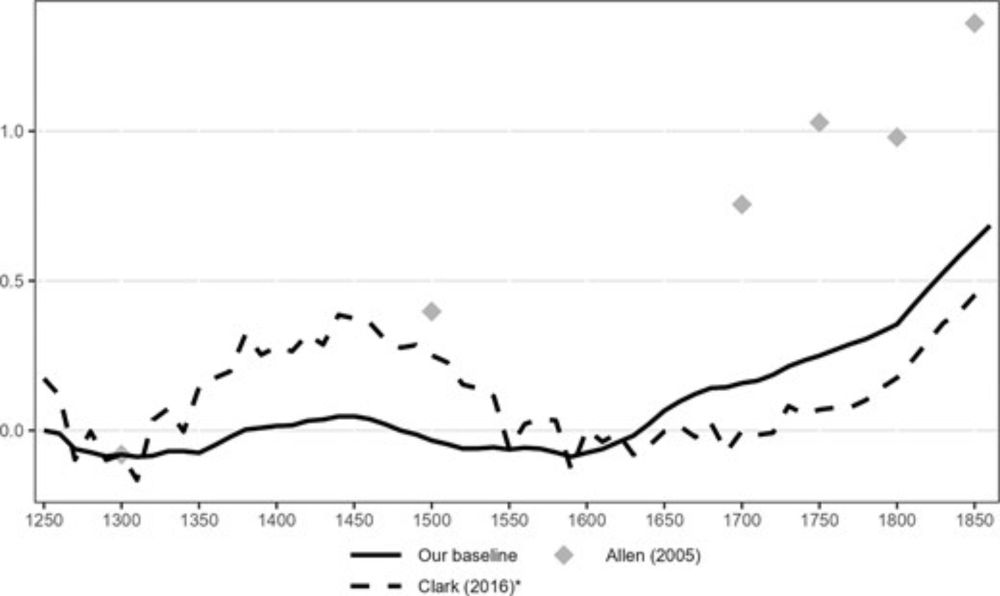
Jón Steinsson 🗽
@jonsteinsson.bsky.social
Economics professor at UC Berkeley.
https://eml.berkeley.edu/~jsteinsson/
https://eml.berkeley.edu/~jsteinsson/
Good to hear from you! But unfortunately I won't be going. Sorry to miss you. Would have been great to catch up.
May 8, 2025 at 2:43 PM
Good to hear from you! But unfortunately I won't be going. Sorry to miss you. Would have been great to catch up.
Reposted by Jón Steinsson 🗽
#QJE May 2025, #1, “When Did Growth Begin? New Estimates of Productivity Growth in England from 1250 to 1870,” by Bouscasse (@paulbouscasse.bsky.social), Nakamura, and Steinsson (@jonsteinsson.bsky.social): doi.org/10.1093/qje/...

When Did Growth Begin? New Estimates of Productivity Growth in England from 1250 to 1870*
Abstract. We estimate productivity growth in England from 1250 to 1870. Real wages over this period were heavily influenced by plague-induced swings in the
doi.org
April 16, 2025 at 6:53 PM
#QJE May 2025, #1, “When Did Growth Begin? New Estimates of Productivity Growth in England from 1250 to 1870,” by Bouscasse (@paulbouscasse.bsky.social), Nakamura, and Steinsson (@jonsteinsson.bsky.social): doi.org/10.1093/qje/...
Hard to tell. But more and more feasible.
February 13, 2025 at 11:25 PM
Hard to tell. But more and more feasible.
We are trending towards less and less cash. So, the fiscal costs of the penny are not likely to balloon fast. So, overall, not a big deal. But on balance I support getting rid of the penny. 9/
February 13, 2025 at 6:21 AM
We are trending towards less and less cash. So, the fiscal costs of the penny are not likely to balloon fast. So, overall, not a big deal. But on balance I support getting rid of the penny. 9/
The attachment argument is the only reasonable argument I can think of in favor of the penny. The economic argument for the penny is super weak (IMHO). But then the argument against the penny is not that strong. $40 million is not a lot of money for a big country. 8/
February 13, 2025 at 6:21 AM
The attachment argument is the only reasonable argument I can think of in favor of the penny. The economic argument for the penny is super weak (IMHO). But then the argument against the penny is not that strong. $40 million is not a lot of money for a big country. 8/
Now, some people are attached to the penny. Just like others are attached to national parks (which the government spends money on). So, perhaps that attachment is worth $40 million a year. Totally reasonable debate. I am not attached to the penny. So, I support getting rid of it. 7/
February 13, 2025 at 6:21 AM
Now, some people are attached to the penny. Just like others are attached to national parks (which the government spends money on). So, perhaps that attachment is worth $40 million a year. Totally reasonable debate. I am not attached to the penny. So, I support getting rid of it. 7/
The rounding issue would be a bigger deal for the nickel. So, it is worth a bit more to keep the nickel. 6/
February 13, 2025 at 6:21 AM
The rounding issue would be a bigger deal for the nickel. So, it is worth a bit more to keep the nickel. 6/
Firms would continue to want to price at $9.99 etc. for psychological reasons. But then taxes are added and you buy several items at a time. The final digit of the total price of your purchase (with taxes) quickly becomes random. So, rounding would be symmetric. 5/
February 13, 2025 at 6:21 AM
Firms would continue to want to price at $9.99 etc. for psychological reasons. But then taxes are added and you buy several items at a time. The final digit of the total price of your purchase (with taxes) quickly becomes random. So, rounding would be symmetric. 5/
Getting rid of the penny would entail rounding of prices. But that is not a big deal. Rounding is symmetric. So, prices need not rise on average and probably wouldn't. 4/
February 13, 2025 at 6:21 AM
Getting rid of the penny would entail rounding of prices. But that is not a big deal. Rounding is symmetric. So, prices need not rise on average and probably wouldn't. 4/
The fiscal cost of the penny is small. About $40 million per year on average. (The cost of the nickel is larger. More like $80 million.) So, modest fiscal savings. 3/
February 13, 2025 at 6:21 AM
The fiscal cost of the penny is small. About $40 million per year on average. (The cost of the nickel is larger. More like $80 million.) So, modest fiscal savings. 3/
It costs 3.7 cents to produce a penny (and rising). So, the government is losing money on the penny. But the government spends money on lots of things. Is it worth it? 2/
February 13, 2025 at 6:21 AM
It costs 3.7 cents to produce a penny (and rising). So, the government is losing money on the penny. But the government spends money on lots of things. Is it worth it? 2/
Next chapter will be about interest rates.
February 11, 2025 at 7:10 PM
Next chapter will be about interest rates.

